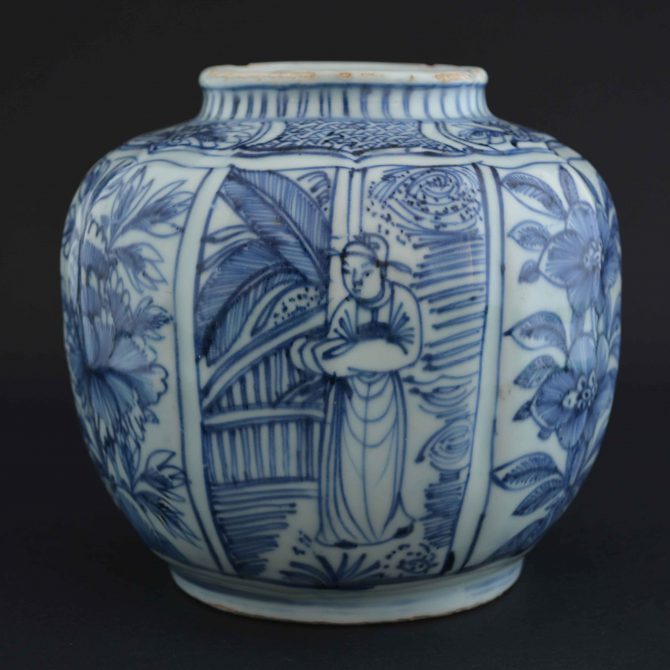
WANLI or TIANQI c.1600 – 1627 Ming Porcelain
An Early 17th Century Ming Blue and White Kraakware Porcelain Jar, Late Wanli (1573-1620) or Tianqi (1621-1627). Decorated in a Silvery Tone of Cobalt blue in the `Pencilled` Style. Decorated with Panels of Scholars in a Garden Landscape with Banana and Panels of Flowers.
SOLD
- Condition
- There is a very fine crack to the shoulder c.30 mm. There is also a star crack to the base c.30 mm. The top is fritted, the lutting line to the middle of the jar is visible.
- Size
- Height : 14 cm (5 1/2 inches)
- Provenance
- Soilveig and Anita Gray. The Jack Johnson Collection of Chinese Porcelain.
- Stock number
- 24236
- References
- For three Ming Kraak Ware Porcelain wine pots of this type see : Kraak Porcelain, A Moment in the History of Trade (Maura Rinaldi, Bamboo Publishing,1989) Pages 182-183 Shape I.4: wine pots. A Ming Porcelain jar of this type but a very crude version is illustrated in : Yuan and Ming Blue and White From Jiangxi (Various authors Jiangxi Provincial Museum and the Art Museum, The Chinese University of Hong Kong,2002) plate 104.
Information
Kraak Ware / Kraak Porcelain :
Kraak Porcelain is a Type of Chinese Export Porcelain Produced from the Wanli period (1573-1620) until the end of the Ming Dynasty in the 1640`s. Kraak ware or Kraak porcelain was the first Chinese Export Ware to arrive in Europe in large quantities. Its name does not, as had been previously thought derived from the name of Portuguese trading ships, it is possible its name derived from Irish ships called Curachs. These trading ships worked between Ireland and England, they were know to the Dutch traders who used a similar word, craquen, to describe Portuguese trading ships. However in the 16th and early 17th centuries the word Kraak was not used in the V.O.C. record or inventories to describe porcelain. The first known time Kraak was first used as a term to describe a type of late Ming blue and white porcelain was in 1673. This was over 100 years after what we now know as Kraak porcelain was first produced, however there is some evidence that it was a term that had been in use for some time. Blue and white porcelain was exported to Europe in large quantities from the mid 16th century. It was highly prized and the Portuguese fort hard against the Dutch to keep control of this lucrative trade, but in 1602 the Dutch sold the cargo they captured from the Portuguese Carrack `San Tiago` and two years later they sold the cargo of the `Santa Catarina`. These ships caused a sensation, it was the first time such large amounts of Chinese blue and white porcelain had been avalible in Northern Europe, many of the pieces were `gifts` rather than to be sold on the open market . All Kraak porcelain was made at the main ceramic centre in China, Jingdezhen. It does vary in style and quality to quite a large extent, and some scholars include pieces as kraakware that others do not, so a definitive description is, I feel, rather difficult. The main group of kraak porcelain is less controversial. Normally thinly potted, often moulded, it`s designs are divided into decorative panels, with reserves that might include flowers and animals, taotie masks and stylised tulips. The bases often show `Chatter Marks`. These are ridges, that radiate from the centre of the base to the foot rim, they are caused by the potters finishing tool catching on the leather hard clay prior to glazing. When one looks at the construction, painting techniques and glazing of kraak porcelain it appears similar in many ways to some of the late Ming porcelain made for the Japanese market. I think it is quite possible that they were both made within the same kilns at Jingdezhen. Kraak porcelain also includes a few rare pieces that have the addition of underglaze copper red and there are a very few know examples of polychrome kraakware. Kraak porcelain went out of fashion at the end of the Ming Dynasty but was later revived during the reign of Kangxi (1662-1722). Swatow porcelain (c.1580-1640) was made in the kraak style but this is thicker and much cruder, the bases often show grit adhering.
The shape of this late Ming Kraakware jar is essentially that of a wine ewer but without a handle or spout.